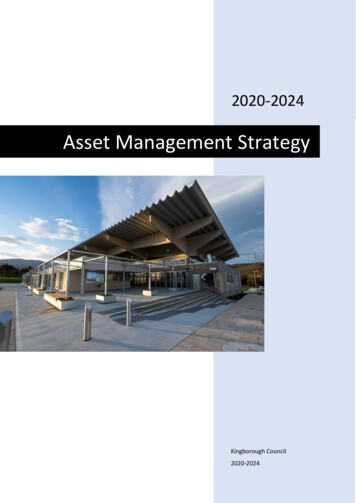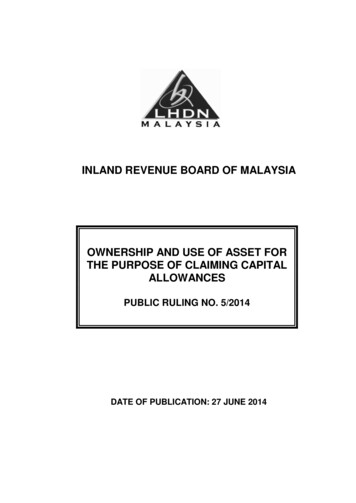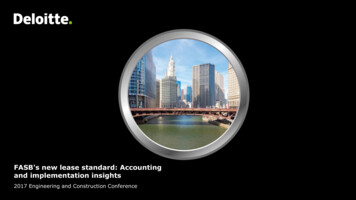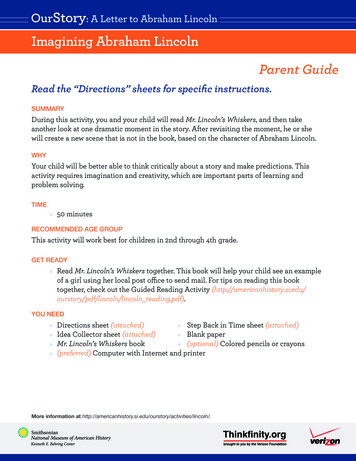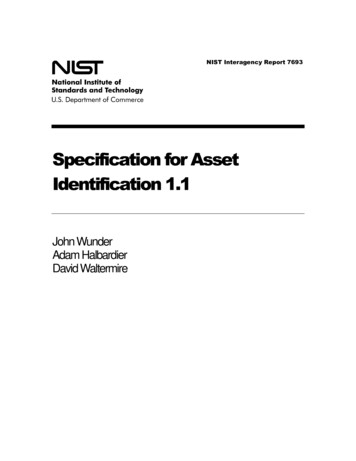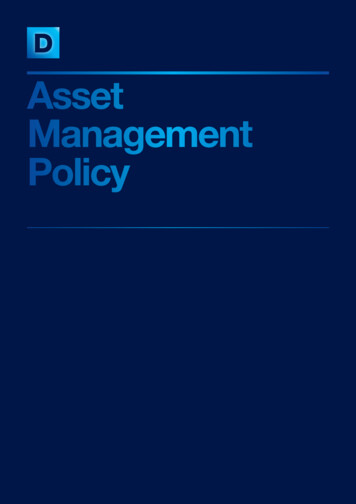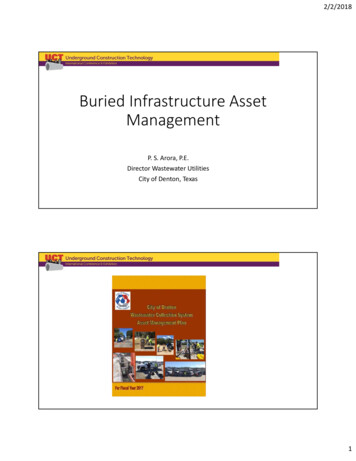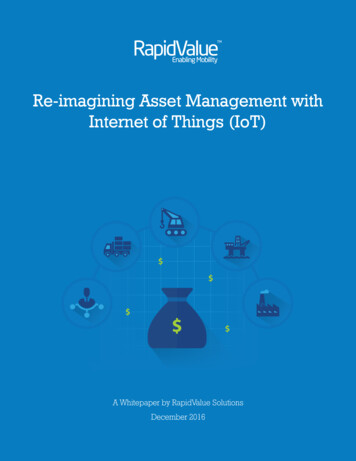
Transcription
Re-imagining Asset Management withInternet of Things (IoT)A Whitepaper by RapidValue SolutionsDecember 2016
ContentsExecutive Summary. 03Demand for Asset Management Solution. 04Variations of Asset Management Objectives. 04Traditional Solutions. 05IoT-enabled Smart Asset Management. 06Advantages of Smart Asset Monitoring over the Traditional Solution. 07Automation. 08Innovation. 08Digital Transformation. 08Conclusion. 09 RapidValue Solutions02
Executive SummaryA lot has been said about ways in which Internet of Things (IoT) can transform companies. Mind numbingfigures in expected savings and CXO surveys showing that majority is already investing or planning toinvest in IoT make it a ‘must look at’ initiative. The moment Internet of Things is brought into an industrialperspective; the benefits are either in one or more of these realms: increasing efficiency, reducing cost orimproving customer experience. Industrial Internet of Things (IIoT) has now become a common word inthe enterprise arena.The Internet of Things is becoming a fast adopted technology solution which is moving from the academiato the industry. This is primarily, due to the explosion of low-cost sensors, affordable connectivity,scalable cloud platforms, ingestion, processing and storage capabilities of vast amounts of structured/unstructured data by the big data platforms, ubiquitous mobile applications, and smart machine learningtools. Technology companies and service providers are increasingly bombarding companies withinnovative solutions and ways on how they can connect things to radically change their businessoperations. Companies have moved beyond the acquaintance phase with Internet of Things and are nowin the ‘let us try’ phase.This paper emphasizes the importance of a smart asset management system in Industrial IoT, itsadvantages over a traditional solution and the components of smart asset management system. RapidValue Solutions03
Demand for Asset Management Solution 6.4T 1.6T 8.0TIoT Value atStakePublic SectorPrivate SectorValue Sources 2.1T 2.1 1.9T 1.2T 0.7TInnovation/RevenueAssetUtilizationSupply nExperienceFigure 1Source: Cisco Consulting Services, 2014A common and predominant application of the IIoT seen across industries is for physical assetmanagement and monitoring and predictive maintenance. A study conducted by Cisco shows that overthe next ten years, the potential bottom-line value that can be created as organizations harness IoTsolutions will be close to 8 trillion dollars and 25% of this or 2.1 trillion dollars is from Asset Utilization.Traditionally asset intensive industries like Manufacturing, Industrial Machinery, Logistics andTransportation, Oil and Gas, Heavy Machinery and Construction, Equipment Rental, etc. are constrainedby lack of visibility of their assets and they continuously try to track their RoA. Most of these companiesare interested in monitoring their assets, the work each asset is doing, whether it is being overworked orunder-utilized, the current location of the asset, the lifetime value of the asset etc. A study conducted byForrester and SAP shows two-thirds of companies in these sectors are using or planning to useIoT-enabled asset monitoring solutions.Variations of Asset Management ObjectivesThe physical assets can be categorized into different groups: human and non-human, moving andnon-moving, on-premise or field asset. The human asset can be your human resources like shop flooremployees, sales executives and field force personnel. The moving assets can be your trucks, trainwagons, cranes and rental cars. Whereas the non-moving assets are the huge machines in your shopfloor, the boilers, long pipelines, gas cylinders, coolers, network towers, etc. Different kinds of assetsbring different challenges and different business objectives for managing them. The manufacturers ofassets, OEMs have different objectives from their asset management and the operator or owner of assetshave different objectives from their asset management. More often, the OEMs want to monitor customer RapidValue Solutions04
data, usage data and improve customer experience by monitoring their assets whereas the owner oroperators monitor the data from a heterogeneous group of assets they own, to better manage andeffectively utilize them. In this paper, most of our asset management discussion will be restricted towardsthe latter use case where increasing efficiency from a heterogeneous mix of assets is the primaryobjective.The matrix shows an indicative list of asset management/asset tracking applications.Mobile AssetsPersonnel/WorkforceFleet TrackingManagementRoute & Fuel OptimizationInventory ControlCondition MonitoringIntegrity MonitoringPredictive MaintenanceAsset LifecycleManagementOn-premise AssetsOn-field AssetsReal-time ControlField Data AutomationPredictive MaintenanceCondition MonitoringOutage ManagementRemote MonitoringPredictive MaintenanceStationary AssetsFigure 2: Common Asset Management Solutions for Different Type of AssetsTraditional SolutionsTraditionally, owners/operators of assets have been using technology solutions to monitor their assets andthey have been using separate operational technology solutions like SCADA systems for over decadesnow. The asset management solutions range from EAM applications, tracking solutions range from simplebarcode or RFID solutions to GPS solutions whereas the process or asset control is predominantlyperformed by M2M systems and SCADA systems. All of these co-exist in parallel inside an organizationand have been used by different stakeholders for solving different purposes. These solutions have beenproviding information on the current status, controlling a process, managing assets, plan maintenancestrategies, track locations and state awareness but they have all been focusing on standalone functions,separate group of stakeholders and disparate processes. RapidValue Solutions05
IoT-enabled Smart Asset ManagementIoT-enabled smart asset monitoring means that the traditional solutions, processes, workforce, andassets are made into more cognizant and integrated unit to work as a ‘single strategic system’ enablingorganizations to transform their operations, digitally. Traditionally, these were operating in silos, whichhave been made into a single all compassing smart solution with web, wireless and analytics. Thus,offering far more advantages than the traditional solutions. This can be dubbed as the transformationaltechnology which can change the game and disrupt business processes.IoT-enabled smart asset monitoring solution does everything that traditional solutions do like letting theorganizations know where the asset is, what is the condition of the asset, manage asset lifecycle, controlprocesses, etc. Also, it adds intelligence to automated workflows, real-time alerts, insights from data,dynamic edge control of assets, predictive maintenance, cross-domain analytics and real-time visibility.ActControlPeopleThings orAssetsCommunicateBusinessProcessSystems &ApplicationsFigure 3: IoT-enabled Solution MeshIoT Smart Asset Management solution typically comprises the following:1. Remote Asset Tracking2. Asset Health/Condition Monitoring3. Asset Lifecycle Management4. Asset Workflow Automation5. Predictive Asset Maintenance RapidValue Solutions06Data
There can be a lot of derived solutions or variations of these to make it specific to an industry or abusiness process. For example, condition monitoring can be as simple as monitoring if a fuel storage tankis full or not to an extent where we can monitor the level of harmful gases, employee vitals etc. in ahazardous environment. One such use of Smart Asset Management in a manufacturing industry asshown in figure 3.VALUEBENEFITSBUSINESS SCENARIOSmart Asset Management - Future Vision Scenario in a Manufacturing Context12An overheating devicemonitored by the SmartAsset Monitoringsends an alert to theplant supervisor. Theequipment send thevalues, the part whichis overheating andother details as well tothe application. Thesupervisor immediatelyassigns a WO for thetechnician via theSmart Asset ServiceRequest automation.The technician canview the values,equipment details,standard operatingprocedures, repairhistory, componentavailability, location etc.on his/her mobieapplication.34He/she visits the exactequipment location andnotices an irreparabledamage to the valveand checks theinventory via mobileinventory managerapp. He raises acomponent issuerequest via and gets onspot approval. Also aequipment lock out isinitiated in the shopfloor to avoid anyproduction in thatequipment.He completes thecomponentreplacement andreal-time updates aredone via mobile servicerequest to the workorder in terms ofcomponentsinstalled/reokaced, timetaken, equipmentimage etc. Theequipment lockout inSmart AssetManagement isremoved to resumenormal productionoperations.5The maintenancemanager analyzes thedata and develops amaintenanceequipment strategy insmart assetmaintenance. He alsomonitors equipment inreal-time and doespredictive maintenancefor critical assets toincrease equipmentuptime.Higher resource productivity and utilization (OEE)Reduce inventory carrying costsImproved first-time fix ratesReduce spare parts inventoryReduced unplanned downtimeImprovement in mean time to repairEliminate admin time of manual paper ordersOptimal performance of facility including thoughput and efficiencyFigure 4: Smart Asset Management in ManufacturingAdvantages of Smart Asset Monitoring over the Traditional SolutionMost companies which have assets on premise or are spread across geographies have a horde ofproblems to deal with. Like poor health of assets, excessive maintenance costs, high mean time to repair,theft, pilferage, underutilization, under performance and more. IoT-enabled Smart Asset Managementbrings in a more holistic approach to asset management and asset monitoring rather than amodule-based approach. IoT-enabled Smart Asset Monitoring provides the right visibility for organizationsto overcome these challenges. The key advantage of IoT is the ability to get to the domain data andseamlessly integrate it with a unified solution so that the management has insights to make the rightdecision. IoT solutions bring in the inherent value of Automation, Innovation, and Digital Transformation. RapidValue Solutions07
AutomationTraditional solutions brought in a lot of information but lacked insight. There was a lot of humaninvolvement, offline data crunching, and iterations to perform actions. The time lag made lot of actionseither reactive or excessive/preventive.IoT solutions connect machine with people, with processes and systems in ways like never before. Thisfacilitates automation. The human intervention is needed only for decision making rather than performingmundane tasks, rule-based preset actions, measuring field data, collecting audit logs for regulatorycompliance. The primary advantage of Smart Asset Monitoring is automating all of this. Thus, increasesthe accuracy, reduces cost, improves process efficiency and eliminates non-compliance. Physical checks,routine tasks and periodic monitoring can all be reduced drastically and now be made based on the actualcondition and usage of the asset.For example, a leading telecom company is using IoT based Smart Asset Monitoring solution toautomatically adjust antenna alignments and has reduced ownership costs by eliminating unnecessarymanual trips to the telecom tower sites.InnovationThe possibilities of bringing in innovative value-add with Smart Asset Management is endless. Dataanalytics at the edge help real-time and near real-time decision making with the help of machine learningand other advanced intelligence. Data from multiple machines integrated with information about theproduct usage can unlock new insights which were never seen before. This will enable the managementto come up with innovative decisions and solutions to face the common challenges that their business hasbeen facing for many years.For example, a company called Sharper Shape is using drones and machine learning as a part of theirasset monitoring to watch the trees that are in the risk of falling into power lines to proactively avoiddisruption.Digital TransformationDigital age businesses are transforming themselves to uniquely combine product and service to offer theirproduct as a service. An IoT solution like Smart Asset Management is a key to bring in new service linesor new business models into the company. Traditionally, the company’s physical assets which were seenas a cost or a burden in the balance sheet can now be effectively managed to bring in additional revenue.With more data, control and insight a company is able to look at trends where they can identify newmarket opportunities. Capitalizing on those opportunities can bring in more revenues to the company.Figure 4 shows the value chain of data that can transform organizations and move from their existingtechnology to become a smart and cognitive organization.For example, a leading crane company based in the United States was previously offering their cranerental services for days or months. With Smart Asset IoT solution, they are looking at enabling Lifting as aservice for their customers where customers can pay for the load they want to lift rather than paying it forthe entire day/month. The company as well can have better control over the equipment usage and canget more revenue from usage of the cranes. RapidValue Solutions08
ConclusionThe ‘Internet of Things’ is here to stay. Smart Asset Management is a new generation concept and acomprehensive enterprise asset management application. It proves to be successful in enabling assetowners to manage and maintain their plant, facilities, and equipment in a much more efficient manner.Smart solutions like Smart Asset Management will be disruptive in nature. Leaders of organizations havelittle choice either to get onboard proactively or be forced to adopt by the competition or to be disrupted.Success will come from partnerships and the entire ecosystem players. Involve experts in the technologyto advice on the impact of this in your business. The rewards at the end of the journey will make thejourney worthwhile. RapidValue Solutions09
This whitepaper is written by Raakesh Rajan, Senior Consultant - Digital BusinessConsulting, RapidValue.Raakesh is part of the Business Consulting team at RapidValue. He helps clients to addvalue to their business through digital initiatives. He has experience implementinglarge-scale digital transformational initiatives and products. Raakesh has worked onmultiple domains such as Manufacturing, Heavy Equipment, Retail, and Oil & Gasindustries. Prior to RapidValue, he was part of Strategy Growth Initiative team atAccenture, to identify the right digital technology solution and the adoption strategy.If you’d like to know more on this subject or learn more on IoT solution offerings byRapidValue, please reach out to us at contactus@rapidvaluesolutions.com.We’d be happy to hear from you! RapidValue Solutions10
About RapidValueA global leader in digital transformation for enterprise providing end-to-end mobility, omni-channel, IoTand cloud solutions. Armed with a large team of experts in consulting, UX design, application development, integration and testing, along with experience delivering projects worldwide, in mobility andcloud, we offer a wide range of services across industry verticals. We deliver services to the world’s topbrands, fortune 1000 companies, Multinational companies and emerging start-ups. We have offices inthe United States, UK and utions.com/blog 1 877.643.1850contactus@rapidvaluesolutions.com
In this paper, most of our asset management discussion will be restricted towards the latter use case where increasing efficiency from a heterogeneous mix of assets is the primary objective. The matrix shows an indicative list of asset management/asset tracking applications. Figure 2: Common Asset Management Solutions for Different Type of Assets
